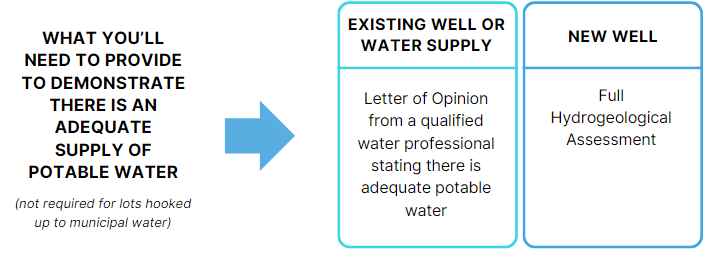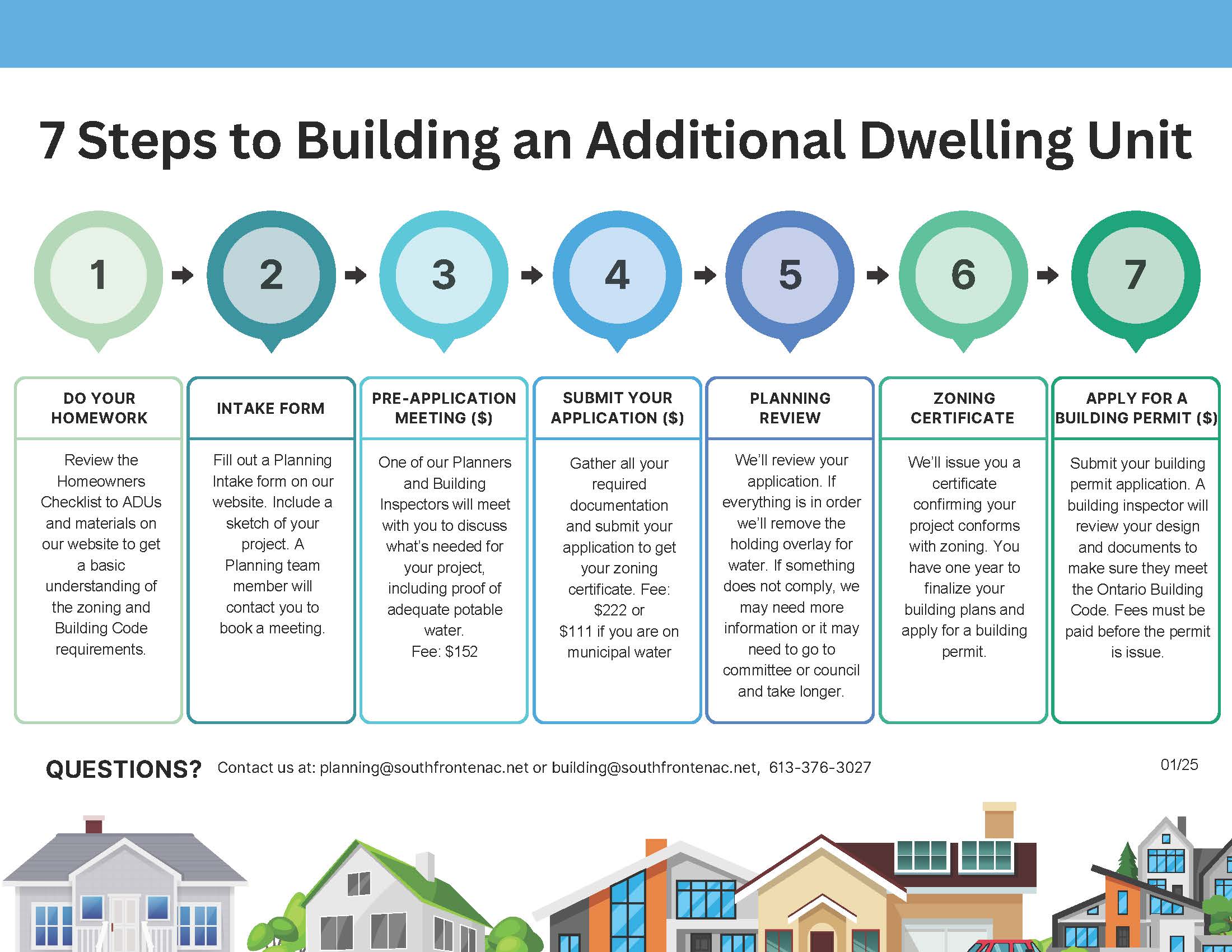In South Frontenac, because all lots are on septic systems and the majority of lots are not on municipal water, a maximum of two additional dwelling units are allowed on one property, one or two in the primary dwelling and one in an accessory building for a total of three residential units on one lot.
Additional Dwelling Units
In 2023, Council passed a by-law to allow additional dwelling units in South Frontenac to create more housing options. The by-law took effect on January 23, 2024.
An additional dwelling unit (ADU) is a self-contained residential unit with its own kitchen, bathroom facilities and sleeping area on a property that already has a house on it. It can be a space within a principal dwelling like a basement apartment or in-law suite, or a separate building on the same lot close to the principal dwelling.
Quick links
- Homeowners Checklist to Additional Dwelling Units
- ADU Application to Remove Holding Overlay and for Zoning Compliance Certificate
- Hydrogeological Assessment Standards
- So You Want to Build an Additional Dwelling Unit?
- Spotlight on ADUs
Submit a Planning Intake Form Pay Online
(submit this form to request a meeting with our planning team to discuss your project or if you are looking for specific information. You will need to submit a sketch with the form.)
General guidelines
In South Frontenac, you can build up to two additional dwelling units on one property, one or two in the primary dwelling and one in an accessory building for a total of three residential units on one lot. The proposal must meet zoning and building code requirements.
The following general rules apply. See our Zoning By-law for full details.
- The maximum gross floor area of the unit must be smaller or equal to the floor area of the principal dwelling.
- In the case where the unit is a separate structure, it must be within 40 metres of the main house.
- Additional dwelling units must share the same driveway entrance with the principal dwelling
- Additional dwelling units are prohibited on lands located in a floodplain, within 90 metres of a lake or river, or within 300 metres of highly sensitive (at-capacity) lake trout lakes
Fees
This table outlines some of the fees you can expect when building an Additional Dwelling Unit. Fees from third party professionals like designers and water professionals will vary.
| Planning Intake meeting | $152 |
| Zoning Application (to remove holding overlay for water and to issue Zoning Compliance Certificate | $374/$264 if on municipal water |
| Sewage System Performance Level Review (if needed) | $515 |
| Letter of Opinion on water or Hydrogeological Assessment | Will vary based on provider |
| Designer/Draftsperson | Will vary based on provider |
| Building Permit Fee | See building permit fees |
Grant programs
Your project may be eligible for a government grant.
Government of Canada Multigenerational home renovation tax credit (MHRTC)
- The Multigenerational home renovation tax credit (MHRTC) is a new refundable tax credit that can be claimed on your income tax and benefit return starting in tax year 2023.
- If you are eligible, you can claim this credit for certain renovation expenses to create a self-contained secondary unit. The secondary unit must allow a senior or an adult who is eligible for the disability tax credit to live with a qualifying relative.
- You can claim up to $50,000 in qualifying expenditures for each qualifying renovation that is completed. The tax credit is 15% of your costs, up to a maximum of $7,500, for each claim you are eligible to make.
Canada Greener Homes Initiative
This program helps homeowners save money and fight climate change by providing grants for energy retrofits.
What is the process to build an ADU?
The process to build an additional dwelling unit is similar to any other zoning or building permit application. It starts with a zoning review, to ensure the project meets the current zoning requirements.
One step unique to ADUs is the requirement of the property owner to demonstrate there is an adequate supply of potable water to support the additional units. This step is not required if the lot is connected to the Sydenham municipal water system.
Once all the zoning requirements are satisfied, we’ll issue a Zoning Compliance Certificate and the property owner can apply for a building permit. The Ontario Building Code lists very specific requirements for ADUs including minimum room sizes, ceiling heights, and specific requirements for exits, windows, plumbing, heating and electrical. We strongly recommend you hire a professional designer who is familiar with the Code to ensure your project meets all the requirements.


Frequently Asked Questions
How many units are allowed on each lot?
What is the process to build an ADU?
The first step is to do some research. Review the Homeowners Checklist to ADUs to get a basic understanding of the zoning and Building Code requirements. The next step is to fill out an intake form and meet with our planning department who will review and discuss your project and go over what’s required from a zoning perspective.
A key requirement will be for you to demonstrate there is an adequate supply of potable water to support the additional units and assess the impact to neighbouring properties. Once this and any other zoning requirements are satisfied, the holding overlay for the property will be removed, we’ll issue a zoning compliance certificate, and you have one year to apply for a building permit.
We’ve made changes to our zoning by-law to establish a Township-wide holding overlay (excluding the area connected to the Sydenham municipal water system). A holding overlay is means that certain conditions need to be met before you can apply for a building permit.
What is needed to demonstrate adequate potable water?
If the additional units will be on an existing well, you will need to provide a Letter of Opinion from a qualified water professional. If it’s a new well, you will need to have a full hydrogeological assessment done by a professional hydrogeologist. We’ve developed standards for hydrogeological assessments which can be found on our website.
What else will the Township look at when considering an ADU proposal?
Staff will look at things like whether the proposal meets size, setback and parking requirements.
Why do separate buildings need to be near the main house?
Additional units need to be near the main house because they share the same driveway and usually share the same well and sewage system. It also minimizes the impact on the natural environment.
I live on waterfront. Can I still build an ADU on my property?
It depends on the property. Additional dwelling units are prohibited on lands located in a floodplain, within 90 metres of a lake or river, or within 300 metres of highly sensitive (at-capacity) lake trout lakes.
Do I need to register my existing Additional Dwelling Unit with the Township?
No, there is no requirement to register existing ADUs at this time.
While we want to support the Province’s goal of building more homes faster, as a rural municipality, we still need to make sure we are growing responsibly and sustainably.
Contact Us
Township of
South Frontenac
Development Services
Mailing address:
4431 George St. Box 100
Sydenham ON, K0H 2T0
T: 613-376-3027
TF: 1.800-559-5862
(if calling within the
613 area code)
planning@southfrontenac.net
NOTE: Our team is working
remotely and in temporary office space
at 3910 Battersea Rd during our
town hall expansion. Please visit us
there if you need to drop by in person
Sign up to receive our monthly newsletter
Stay up to date on Township news, events and projects by subscribing to our monthly newsletter.
